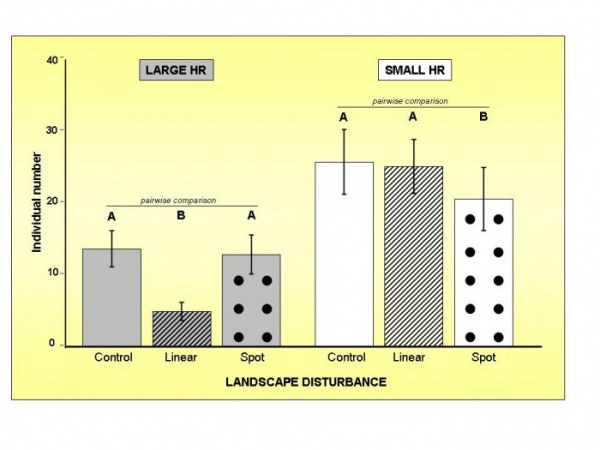Result and Discussion
A boxplot (fig. 3)
showed, for Small HR, that Spot Disturbance had more of an effect than
Linear Disturbance over number of individuals. This result differs with
the hypothesis because it was expected than Linear Disturbance would
have the major effect on population size for both animals. Therefore,
this difference implies not only a difference in the magnitude of
response, but also a dissimilar direction of response for each species.
The examination of each movement treatment has shown a differences
between Regions (e.g. Region V for Small HR).
ANOVA tests
showed a significant effect of Landscape Disturbance in both Animal
Movements (tables Xa,b ). The Region had also a significant effect
(p<0,0001) for Small HR .
Pairwise comparison for Landscape
Disturbance (figure X) showed for Small HR, Spot Disturbance was
significant different from the Control (p=0,005) and Linear Disturbance
(p=0,098), while for Big HR, Linear Disturbance was significant
different than Control (p=0,028) and Spot Disturbance (p=0,042).
Figure 4. ANOVA TEST RESULT AND PAIRWISE COMPARISION

Axes
X, Linear Disturbance Treatment for both Animal Movement. Axes Y, Mean
of Individual Number. Black line, SE estimated with Region as
repetition (N=4 for Large HR and N=5 for Small HR).
Anova
test was development independenlly for Large HR and Small
HR. For Small HR, Anova test showed a significant effect of
Region.
These results (Fig. 4) differ in part with the hypothesis because it was expected than both disturbances affected significantly the observed number of both species. The stronger effect of Spot Disturbance for Small HR species could be explained by two reasons; (1) factors related to human hunting activities or presence of domesticated dogs, (2) the species with more restricted movement have less capacity of avoid the impacts that occur in their habitat and inversely the species with greater mobility could move away from a disturbance. Either of these could explain why the species with Big HR was not impacted significantly by Spot Disturbance.

